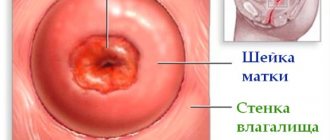What is cervical eschar
After surgery, a cell layer forms on the cervix at the site of the open wound, which is a collection of dead tissue and clots of coagulated blood. In appearance it is a crust that forms on the skin after injury.
The use of a laser, radio waves or electrical loop produces heat or radiation. Under their influence, protein denaturation occurs - it loses its properties. The cell is destroyed.
Scab – photo
This protective layer serves as a barrier to the penetration of various pathogenic microorganisms and bacteria into the blood through the wound. By covering exposed wounds at the site of impact, the scab protects tissue from bleeding. A new layer of epithelium will very soon form under it.
Removal of the scab after conization of cervical erosion
After surgery, many women are concerned about the discharge of various contents.
In addition to the usual bloody ones, a small clot in the form of dried crusts attracts special attention. This concept in gynecology is called “cervical scab.” This article will talk about what a cervical scab looks like, what it is, what symptoms accompany scab rejection, and what recommendations should be followed during this process.
What is cervical eschar
After surgery, a cell layer forms on the cervix at the site of the open wound, which is a collection of dead tissue and clots of coagulated blood. In appearance it is a crust that forms on the skin after injury.
The use of a laser, radio waves or electrical loop produces heat or radiation. Under their influence, protein denaturation occurs - it loses its properties. The cell is destroyed.
Scab – photo
This protective layer serves as a barrier to the penetration of various pathogenic microorganisms and bacteria into the blood through the wound. By covering exposed wounds at the site of impact, the scab protects tissue from bleeding. A new layer of epithelium will very soon form under it.
What not to do
The healing process and rehabilitation period largely depend on the regimen and responsible behavior of patients at this time. A scab formed on the cervix protects the injured area on the surface of the uterus from damage.
It promotes the wound healing process and the formation of new epithelial cells underneath. Keeping the scab intact is very important for further recovery.
Damage to it will lead to an exacerbation of the disease and the occurrence of undesirable side effects.
- Do not swim in open waters or pools;
- Do not visit baths and saunas, avoid overheating the body;
- Avoid hot baths and take only showers;
- Do not sunbathe in the sun;
- Do not use a heating pad to relieve pain;
- Minimize physical activity, do not lift heavy objects;
- Temporarily abstain from sexual activity;
- Do not douche;
- Do not use tampons.
Gynecologists recommend abstaining from sexual intercourse for two months after surgery. This time is enough for complete tissue restoration at the wound site.
The implementation of these recommendations requires special attention. Violation of the rules will cause relapse and repeated pathology, the treatment of which will be more complex and lengthy.
Symptoms of eschar rejection
The postoperative period is accompanied by bleeding from the vagina, similar in nature to menstrual bleeding. Some women experience heavy, watery discharge with a small amount of blood clots at first. Thicker and darker ones appear when the scab comes out.
Scab detachment is accompanied by the following symptoms:
- Pain in the lower abdomen, similar in intensity to menstruation;
- Unpleasant odor of vaginal discharge;
- Change in the color of vaginal discharge to a darker color;
- Increased volume of secretions.
To relieve pain, take ibuprofen or ketoral.
In most cases, the scab comes off painlessly.
Medications cannot be used
Photos – medical preparations
On the days when the scab comes off, the discharge becomes very copious. It is strictly forbidden to take blood thinning medications. These include:
- Aspirin – acetylsalicylic acid;
- Atherocardium;
- Warfarin;
- Heparin;
- Clexane;
- Lospirin.
Conization
In this procedure, a cone-shaped area of the cervix affected by the disease is removed. It is used for the diagnosis and treatment of the following diseases: scars on the cervix, polyps and cysts, dysplasia, hypertrophy, early stages of cancer. The methods used are laser, knife and loop (radio wave).
Healing takes about three months, depending on the method of intervention. Scab rejection begins in the second week. Accompanied by copious discharge mixed with blood.
Cauterization of erosion
Cauterization of cervical erosion is characterized by the same symptoms as with conization. According to the method of implementation, it refers to surgical operations. After the procedure, you must follow the general rules of the regime and all recommendations. With any type of discharge, dark pieces come out on days 7–16. These are scab particles.
Biopsy
For examination, a small piece of tissue is excised from the uterus. Indications are deviations in the results of cytology smears.
Proper preparation for surgery reduces the risk of complications and side effects. The biopsy material is sent to identify cancer cells. Depending on the size of the excision and the area of the affected area, the scab comes out within 5–20 days.
Infections cause complications
In the presence of infectious inflammations that are sexually transmitted, the discharge has a dark yellow or greenish color. The reason for this may be vaginitis, adnexitis, salpingitis.
Treatment, depending on the complications, may vary. Anti-inflammatory medications and vaginal suppositories are sufficient. In advanced cases, it comes to surgery to remove the ovaries.
When you need specialist help
Without pathologies, after the scab is removed, the patient begins to bleed slightly. A normal physiological reaction is considered to be one when they go away on their own after two to three hours. The cause of prolonged bleeding, more than six hours, may be a ruptured vessel. It is necessary to urgently consult a doctor to bandage it or do cauterization.
Sometimes the release of dead tissue is accompanied by painful sensations. Bloody discharge becomes profuse. This condition is caused by damage to the cervical tissue at the site of intervention.
It is necessary to contact a gynecologist to treat the damaged area. This will help stop the bleeding. To prevent possible complications, it is recommended to undergo a course of antibiotic therapy.
- Copious discharge of a bright red color, reminiscent of bleeding;
- Severe itching appeared;
- Sharp, cutting pain;
- Chills and fever.
Discharge with blood is the reason that the scab comes off before the time required for complete healing of the uterus. At the same time, the new layer of epithelium underneath has not yet fully formed.
Reviews from various sources
Sveta Armanova, 32 years old.
She survived a deep canalization about a year ago. They did it for me using a laser, which was more expensive than other methods, but as the doctor explained, it was safer in my case. The period after the operation was quite easy and painless.
I observed the heaviest bleeding within 2 days, after which it became moderate and clear. After recovery and return to a more normal lifestyle and work, the discharge turned pink for several days, which was probably caused by increased physical activity.
The scab went away after about a week, I realized this by the presence of a clot on the sanitary pad.
Irina Bob, 39 years old.
Recently I underwent canalization of the cervix, as grade 3 dysplasia was discovered. The operation took place under general anesthesia and lasted no more than 30 minutes. After two hours spent under the supervision of a doctor, she was sent home.
For the first few hours I felt a nagging pain like menstruation and dizziness, sometimes nausea, I think it was coming off from the anesthesia.
The recovery went well, once I noticed that the color of the discharge had become darker, I turned to my gynecologist, who explained to me that the scab had come off and healing was taking place. This happened on about 9 days.
You need to monitor your health, especially when it comes to the female reproductive system, very carefully and periodically visit a gynecologist. In the first stages of the disease, you can solve any problem without harming yourself.
The formation of a scab and its release is a normal physiological reaction after surgical procedures. Every woman needs to monitor her condition after surgery. By following the basic rules, the likelihood of complications is reduced. If adverse symptoms occur, it is recommended to seek help from a medical facility as soon as possible.
Source: https://sheika-matka.ru/lechenie/strup-shejki-matki/
What not to do
The healing process and rehabilitation period largely depend on the regimen and responsible behavior of patients at this time. A scab formed on the cervix protects the injured area on the surface of the uterus from damage. It promotes the wound healing process and the formation of new epithelial cells underneath. Keeping the scab intact is very important for further recovery. Damage to it will lead to an exacerbation of the disease and the occurrence of undesirable side effects.
CAREFULLY. To avoid damaging the scab, patients must adhere to the following rules.
- Do not swim in open waters or pools;
- Do not visit baths and saunas, avoid overheating the body;
- Avoid hot baths and take only showers;
- Do not sunbathe in the sun;
- Do not use a heating pad to relieve pain;
- Minimize physical activity, do not lift heavy objects;
- Temporarily abstain from sexual activity;
- Do not douche;
- Do not use tampons.
Gynecologists recommend abstaining from sexual intercourse for two months after surgery. This time is enough for complete tissue restoration at the wound site.
The implementation of these recommendations requires special attention. Violation of the rules will cause relapse and repeated pathology, the treatment of which will be more complex and lengthy.
Symptoms of eschar rejection
The postoperative period is accompanied by bleeding from the vagina, similar in nature to menstrual bleeding. Some women experience heavy, watery discharge with a small amount of blood clots at first. Thicker and darker ones appear when the scab comes out.
Scab detachment is accompanied by the following symptoms:
- Pain in the lower abdomen, similar in intensity to menstruation;
- Unpleasant odor of vaginal discharge;
- Change in the color of vaginal discharge to a darker color;
- Increased volume of secretions.
To relieve pain, take ibuprofen or ketoral.
In most cases, the scab comes off painlessly.
Medications cannot be used
Photo - medications
On the days when the scab comes off, the discharge becomes very copious. It is strictly forbidden to take blood thinning medications. These include:
- Aspirin – acetylsalicylic acid;
- Atherocardium;
- Warfarin;
- Heparin;
- Clexane;
- Lospirin.
Various operations and scab
Surgery by any method entails tissue damage. The duration of recovery and rehabilitation period depends on the complexity of the operation performed, the stage of the disease and general health.
Conization
In this procedure, a cone-shaped area of the cervix affected by the disease is removed. It is used for the diagnosis and treatment of the following diseases: scars on the cervix, polyps and cysts, dysplasia, hypertrophy, early stages of cancer. The methods used are laser, knife and loop (radio wave).
Healing takes about three months, depending on the method of intervention. Scab rejection begins in the second week. Accompanied by copious discharge mixed with blood.
Cauterization of erosion
Cauterization of cervical erosion is characterized by the same symptoms as with conization. According to the method of implementation, it refers to surgical operations. After the procedure, you must follow the general rules of the regime and all recommendations. With any type of discharge, dark pieces come out on days 7–16. These are scab particles.
Biopsy
For examination, a small piece of tissue is excised from the uterus. Indications are deviations in the results of cytology smears.
Proper preparation for surgery reduces the risk of complications and side effects. The biopsy material is sent to identify cancer cells. Depending on the size of the excision and the area of the affected area, the scab comes out within 5–20 days.
Features of the operation
Regardless of the type of operation chosen, a wound surface is formed on the cervix. During the process of conization, the top layer is destroyed under the influence of laser, electricity or radio waves. In place of the damaged cells, a scab forms, which comes off over time.
- In most clinics, women are offered conization with a special electric loop. This method is considered optimal in terms of price-quality ratio. The cost of loop conization is low. In this case, the tissue of the cervix is minimally damaged.
During the operation, the problem area is cut out in the shape of a cone. Damaged vessels are coagulated immediately after the operation is completed. The excised area remains intact during the operation, so it can be sent for histological examination. An eschar forms in most women after conization with electric loops. But not everyone notices how he moves away.
- Laser surgery is more expensive. Using a laser, you can cut out the damaged part of the cervical canal and cervix as accurately and accurately as possible. The undeniable advantage of such an operation is the fact that during its implementation the doctor can change the intensity and depth of laser exposure. This means that during the process of conization, the surgeon can change the size of the excised area depending on the picture that opens.
- Radio wave conization is considered a highly effective method that allows you to get rid of a number of cervical pathologies. A scab after such an operation is formed in the same way as after conization with electric loops. During the process of radioconization, the area with pathologically altered tissues is cut out, and the vessels are immediately coagulated. The likelihood of complications or infection is minimal.
- Excision of the pathological area on the cervix with a surgical scalpel is currently practically not performed. When performed, complications often develop, since the method is quite traumatic. With the knife method, part of the cervix was cut out with a regular scalpel; healing took a long time and was accompanied by complications in many patients.
The likelihood of negative consequences when performing modern operations is minimized. But sometimes complications arise.
Infections cause complications
In the presence of infectious inflammations that are sexually transmitted, the discharge has a dark yellow or greenish color. The reason for this may be vaginitis, adnexitis, salpingitis.
Treatment, depending on the complications, may vary. Anti-inflammatory medications and vaginal suppositories are sufficient. In advanced cases, it comes to surgery to remove the ovaries.
When you need specialist help
Without pathologies, after the scab is removed, the patient begins to bleed slightly. A normal physiological reaction is considered to be one when they go away on their own after two to three hours. The cause of prolonged bleeding, more than six hours, may be a ruptured vessel. It is necessary to urgently consult a doctor to bandage it or do cauterization.
Sometimes the release of dead tissue is accompanied by painful sensations. Bloody discharge becomes profuse. This condition is caused by damage to the cervical tissue at the site of intervention.
It is necessary to contact a gynecologist to treat the damaged area. This will help stop the bleeding. To prevent possible complications, it is recommended to undergo a course of antibiotic therapy.
IMPORTANT! Contact your doctor for help in the following cases:
- Copious discharge of a bright red color, reminiscent of bleeding;
- Severe itching appeared;
- Sharp, cutting pain;
- Chills and fever.
Discharge with blood is the reason that the scab comes off before the time required for complete healing of the uterus. At the same time, the new layer of epithelium underneath has not yet fully formed.
Postoperative period
Women who are faced with the need to undergo conization of the cervix are worried. They are interested in how the operation itself is performed and how the postoperative period goes. Doctors warn that you should not rely on the experience of other women. The sensations will depend on the following factors:
- pain threshold;
- cervical conditions;
- size of the remote area;
- individual reaction to anesthesia;
- features of the operation;
- the amount of scab formed and the intensity of its discharge.
Patients who underwent conventional knife conization often complained of intense bleeding and severe pain after surgery. The removal of the scab was often accompanied by bleeding.
After the knife method, an inelastic scar may remain on the cervix. It does not bother a woman, but can cause problems during pregnancy and childbirth. Sometimes scars remain after electroloop conization. And laser and radio wave procedures, as a rule, do not leave traces.
For many, healing occurs in 4-6 weeks. But in some cases, the process lasts up to 4 months - the duration depends on the individual ability of the body to regenerate tissue.
If there were no problems during conization, and the woman adheres to the doctor’s recommendations, then the likelihood of complications occurring is minimal. Many patients do not even have blood in the first month, they only have copious watery discharge. Blood or spotting may appear only when the scab is removed.
In the postoperative period, women face the following problems:
- bleeding within 2-3 weeks after surgery;
- pain in the lower abdomen, similar in intensity to pain during menstruation;
- an increase in the volume of bloody discharge when the scab passes;
- unpleasant vaginal discharge.
Pain and increased volume of discharge may indicate damage to the tissue of the cervix and the onset of bleeding. An unpleasant odor appears when the damaged area is affected by pathogenic microorganisms.
Within a week after surgery, most patients begin to lose the scab. This may significantly increase the volume of discharge. For many, they become not only more abundant, but also darker.
In rare cases, bleeding may occur if the scab begins to come off. In such a situation, immediate hospitalization of the patient is required.
Some women who have undergone such an operation do not even know when the scab comes off after conization of the cervix. The formation and rejection of the crust in some patients is completely asymptomatic. They do not feel pain and do not notice an increase in the volume of discharge.
Reviews from various sources
Sveta Armanova, 32 years old.
She survived a deep canalization about a year ago. They did it for me using a laser, which was more expensive than other methods, but as the doctor explained, it was safer in my case. The period after the operation was quite easy and painless. I observed the heaviest bleeding within 2 days, after which it became moderate and clear. After recovery and return to a more normal lifestyle and work, the discharge turned pink for several days, which was probably caused by increased physical activity. The scab went away after about a week, I realized this by the presence of a clot on the sanitary pad.
Irina Bob, 39 years old.
Recently I underwent canalization of the cervix, as grade 3 dysplasia was discovered. The operation took place under general anesthesia and lasted no more than 30 minutes. After two hours spent under the supervision of a doctor, she was sent home. For the first few hours I felt a nagging pain like menstruation and dizziness, sometimes nausea, I think it was coming off from the anesthesia. The recovery went well, once I noticed that the color of the discharge had become darker, I turned to my gynecologist, who explained to me that the scab had come off and healing was taking place. This happened on about 9 days.
You need to monitor your health, especially when it comes to the female reproductive system, very carefully and periodically visit a gynecologist. In the first stages of the disease, you can solve any problem without harming yourself.
The formation of a scab and its release is a normal physiological reaction after surgical procedures. Every woman needs to monitor her condition after surgery. By following the basic rules, the likelihood of complications is reduced. If adverse symptoms occur, it is recommended to seek help from a medical facility as soon as possible.
You can share your opinion about whether the article was useful in the comments. Posting this information on social media will help clarify the situation for those concerned about this sensitive issue.
Conization of the cervix | Page 10
33,864 replies
Latest - Yesterday, 01:57 Go
Flower
Conization was done on September 30th, under anesthesia, everything is fine, the histology is good, but I’m so tired of bleeding! On the 9th day, the scab came off, at first it bled, then it started leaking, we went by ambulance to the same hospital, they gave me an antibiotic, they injected me with dicinone, and they treated my neck.
It’s still leaking, the doctor suggested that it was my period that started, I bought pads, and they were used for some kind of undermining. Second day at home, he still digs in and doesn’t think about stopping. I drink water pepper solution - to no avail, in my opinion. Probably also some kind of vessel.
On Monday morning I will go to the clinic.











